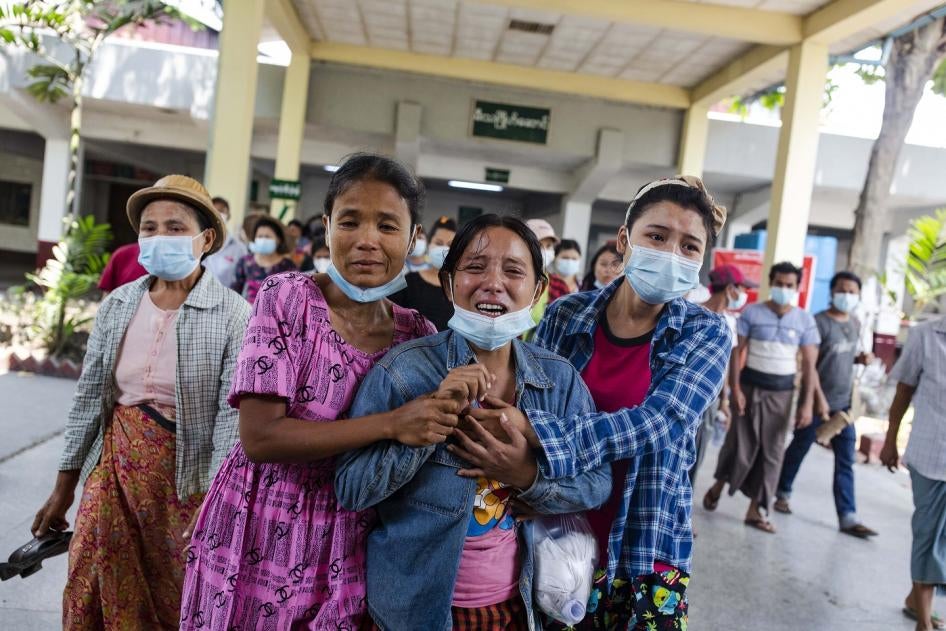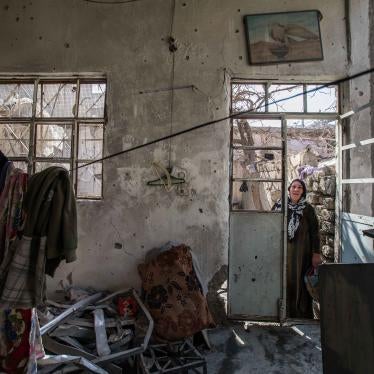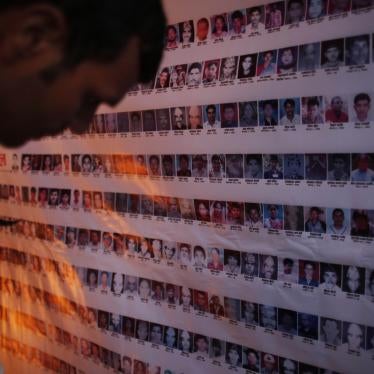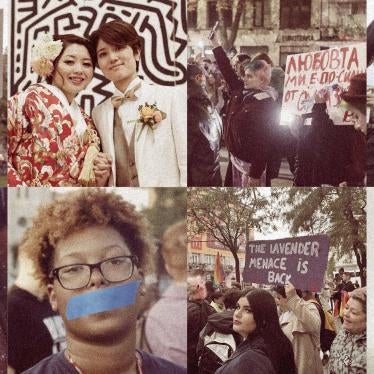(Bangkok) – Myanmar’s military junta has committed numerous abuses against the population that amount to crimes against humanity in the six months since the February 1, 2021 coup, Human Rights Watch said today.
Since the military takeover, millions of people have taken to the streets across the country and peacefully protested for a return to a democratically elected civilian government. As part of a widespread and systematic attack on the population, security forces have repeatedly fired on and otherwise used excessive force to disperse and harm protesters. Police and soldiers have killed over 900 protesters and bystanders, including about 75 children, forcibly disappeared over 100 persons, and tortured and raped an unknown number in custody. Several thousand people have been arbitrarily arrested and detained.
“Myanmar’s junta has responded to massive popular opposition to the coup with killings, torture, and arbitrary detention of people who merely want last year’s election results to be respected and a government that reflects the popular will,” said Brad Adams, Asia director. “These attacks on the population amount to crimes against humanity for which those responsible should be brought to account.”
The concept of crimes against humanity dates to at least 1915 and was part of the 1945 Charter of the International Military Tribunal that created the Nuremberg trials of Nazi leaders. Under the Rome Statute of the International Criminal Court (ICC), crimes against humanity are a series of offenses that are knowingly committed as part of a widespread or systematic attack directed against any civilian population.
The offenses of Myanmar’s junta against those opposed to the military coup have been both a widespread and systematic attack against the population, Human Rights Watch said. The nature of the response, broad-based and frequently consistent, reflects government policy rather than the actions of individual security personnel.
Apparent crimes against humanity committed since February 1 include murder, enforced disappearance, torture, rape and other sexual violence, severe deprivation of liberty, and other inhumane acts causing great suffering. Human Rights Watch previously found that Myanmar’s military had committed crimes against humanity against the ethnic Rohingya population in 2012-2013 and again in 2017 as part of campaigns of ethnic cleansing. The authorities are committing crimes against humanity of apartheid, persecution, and severe deprivation of liberty against Rohingya currently living in Rakhine State. The UN-backed Independent Investigative Mechanism for Myanmar (IIMM) is “closely following” events and is collecting evidence of possible crimes committed following the coup. The IIMM is also mandated to build case files to support efforts to hold individuals responsible for such crimes in criminal proceedings.
The United Nations, regional bodies, and governments, including the European Union, United States, and Association of Southeast Asian Nations (ASEAN), should respond to the continuing crimes against humanity in Myanmar by supplementing, strengthening, and coordinating international sanctions against the military and the State Administration Council (SAC) junta leadership under Sr. Gen. Min Aung Hlaing. Actions should include targeted sanctions on individuals, a global arms embargo, and financial restrictions that would reduce the junta’s revenues from extractive industries.
Governments should act to reduce the junta’s gas revenues, which are the military’s largest source of foreign currency income, adding up to about US$1 billion annually in duties, taxes, royalties, fees, tariffs, and other profits. The US, EU, UK, and others should block payments to the junta and state-owned enterprises from foreign-financed oil and gas projects, such as those operated by PTT, Total, and Chevron. Such measures can be designed to target the junta’s access to foreign accounts while allowing for the continued production of gas and electricity in the country.
Since the coup, concerns about vetoes by China and Russia have deterred the United Nations Security Council from adopting resolutions to address the human rights crisis in Myanmar. The Security Council should urgently take measures against the junta, including by referring the situation in the country to the International Criminal Court (ICC), Human Rights Watch said. The court’s prosecutor is currently investigating the crimes against humanity of deportation and persecution following the 2017 ethnic cleansing of the Rohingya, as those crimes were completed in Bangladesh, an ICC member. The council should follow the June resolution of the UN General Assembly with its own resolution to impose a legally binding arms embargo and targeted sanctions on junta officials and key military leaders.
The Security Council and UN member countries should end the pretense that ASEAN will place sufficient pressure on the junta to restore a democratically elected civilian government, release political prisoners, and hold those responsible for abuses to account, Human Rights Watch said. Since its summit meeting on April 24, ASEAN has failed to appoint a promised special envoy and has taken no meaningful steps to press the junta to address grave human rights concerns in Myanmar.
“The international response to the Myanmar junta’s crimes against humanity has been stymied by fears of Security Council vetoes, ASEAN’s feckless leadership, and the EU’s hesitance to target foreign gas companies,” Adams said. “The Security Council and influential countries, notably the US, EU, Australia, Japan, India, and Thailand, should apply coordinated sanctions to pressure the junta to end its brutal repression.”
Alleged Crimes Against Humanity Since the February 1 Coup
The Rome Statute of the International Criminal Court defines crimes against humanity as one of several offenses “committed as part of a widespread or systematic attack directed against any civilian population, with knowledge of the attack.” “Widespread” refers to the scale of the acts or number of victims. A “systematic” attack indicates a pattern or methodical plan. Crimes against humanity can be committed during peacetime as well as during armed conflict.
The statute defines “attack” as a “course of action involving the multiple commission of acts … pursuant to or in furtherance of a State or organizational policy.” The “attack” does not need to be a military attack as defined under international humanitarian law. Furthermore, “the term ‘population’ does not require that crimes against humanity be directed against the entire population of a geographical territory or area.”
The ICC statute’s Explanatory Memorandum states that crimes against humanity “are particularly odious offenses in that they constitute a serious attack on human dignity or grave humiliation or a degradation of one or more human beings. They are not isolated or sporadic events but are part either of a government policy (although the perpetrators need not identify themselves with this policy) or of a wide practice of atrocities tolerated or condoned by a government or a de facto authority.”
Myanmar is not a party to the ICC, but the UN Security Council could refer the situation in the country to the ICC.
The Myanmar military’s killing of numerous protesters, enforced disappearance of opposition supporters taken into custody, torture and rape of many of those detained, and mass political detentions throughout Myanmar since the coup indicate that these abuses are widespread.
The authorities have made statements that suggest that the response to the protests has also been systematic. On February 21, the State Administration Council stated in the government’s Global New Light of Myanmar: “Protesters are now inciting the people, especially emotional teenagers and youth, to a confrontation path where they will suffer the loss of life.”
On March 26, the state MRTV news channel announced that demonstrators “should learn from the tragedy of earlier ugly deaths that you can be in danger of getting shot to the head and back” and warned that “parents should also talk their children out of it [joining protests], let’s not waste lives for nothing.” This language was widely interpreted to signal that the security forces were planning to respond with force to planned protests the next day, Armed Forces Day.
In a May 8 statement, the junta formally designated the opposition National Unity Government (NUG), its parliamentary committee, and their offshoot militias as “terrorist groups” for alleged acts of incitement against the junta, seemingly to justify a broad suppression campaign. The junta said that the Committee Representing Pyidaungsu Hluttaw (CRPH) – composed of members of the majority party from the 2020 elections of the national parliament – and the NUG “constantly incited Civil Disobedience Movement participants to commit violent acts.”
The following alleged crimes against humanity should be independently and impartially investigated:
Murder
Since the February 1 coup, the State Administration Council junta has responded to massive protests with excessive and lethal force. The police and military have killed over 900 people, most of whom were protesters and bystanders in many cities and towns across Myanmar, including Yangon (Hlaing Thayar, North Okkapala, and other townships), Mandalay, Bago, Monywa, and other townships in Sagaing region, Mindat township in Chin state, and other locations. International human rights standards permit law enforcement officials to use lethal force only as a last resort when there is an imminent threat to life. But in numerous cases reported in the media, and by the UN, Human Rights Watch, and other human rights organizations, the security forces fired on demonstrators who were unarmed and posed no apparent threat.
UN High Commissioner for Human Rights Michelle Bachelet on April 13 denounced “yet another weekend of coordinated bloodshed in many parts of the country.” She said that “[t]he military seems intent on intensifying its pitiless policy of violence against the people of Myanmar, using military-grade and indiscriminate weaponry.”
The UN Human Rights Committee, in its General Comment No. 37 on the right of peaceful assembly, has stated that “[f]irearms are not an appropriate tool for the policing of assemblies, and must never be used simply to disperse an assembly.… [A]ny use of firearms by law enforcement officials in the context of assemblies must be limited to targeted individuals in circumstances in which it is strictly necessary to confront an imminent threat of death or serious injury.”
The crime against humanity of murder has been defined by ad hoc international tribunals as “the death of the victim which results from an act or omission by the accused, committed with the intent either to kill or to cause serious bodily harm with the reasonable knowledge that it would likely lead to death.”
There have been a number of reports of large-scale shooting of protesters by the security forces. The UN reported that security forces killed 18 people on February 28. On March 3, security forces across the country fired live rounds at protesters, killing at least 38 and wounding more than 100, the UN reported. Killings were also reported in one day in Monywa, Sagaing region; Myingyan and Mandalay, Mandalay region; Salin, Magway region; and Mawlamyine, Mon state, according to media reports and local analysts.
Human Rights Watch investigated incidents in which security personnel appeared to deliberately kill individuals. On March 3 in Yangon, at least 10 security force personnel were captured on video pushing a man ahead of a group of detainees and then fatally shooting him in the back at close range.
Medical doctors told Human Rights Watch that security forces prevented them from reaching wounded protesters, some of whom died from blood loss. Doctors working in mobile clinics during protests said security forces used live rounds interspersed with rubber bullets and that many of the fatal injuries were from bullet wounds to the upper body.
On March 13, the authorities killed at least nine protesters, including five in the Sein Pan area of Mandalay, when security forces reportedly shot into a crowd. On March 14 in Hlaing Thayar township, Yangon, security forces killed an estimated 58 people.
On March 17, police pursuing protesters forced their way into Sandar Linn Shein’s family home in Bayintnaung, Mayangone township. She said they accused the family of sheltering protesters and began shooting indiscriminately, killing her older sister instantly and wounding her older brother in the chest and then arresting him.
On March 27, Armed Forces Day, the day after the MRTV news channel announced that demonstrators “should learn from the tragedy of earlier ugly deaths that you can be in danger of getting shot to the head and back,” security forces carried out violent crackdowns on protesters in at least 40 towns and cities, killing dozens, Fortify Rights reported: “Eyewitness photographs and videos filmed [on March 27] show dead bodies, including children, and soldiers firing weapons street-level, dragging lifeless victims away, and brutally beating people.”
In one case, security forces shot and wounded Aye Ko during a night raid in Mandalay. Local media reported that security forces dragged him away and then set him on fire. Residents said soldiers threatened to shoot anyone who tried to help him. In a another widely publicized incident on March 27, a video shows soldiers shooting and killing Kyaw Min Latt at close range as he drove by them on a motorcycle.
On April 9, military personnel killed an estimated 82 people in Bago in a dawn assault on protesters’ barricades and encampments, according to media reports.
On May 26, the Associated Press, in conjunction with the Human Rights Center Investigations Lab at the University of California, Berkeley, published an extensive and detailed report documenting killings. The AP and Human Rights Center alleged that the junta was using the killings, including by dragging bodies through the streets and returning mutilated corpses to families, to terrorize the population into ending the protests. They identified more than 130 instances in which “security forces appeared to be using corpses and the bodies of the wounded to create anxiety, uncertainty, and strike fear in the civilian population.”
Enforced Disappearances
Since the coup, Myanmar authorities have taken into custody and forcibly disappeared more than 100 politicians, election officials, journalists, activists, and protesters, and refused to confirm their location in violation of international law.
Enforced disappearances are defined in the ICC statute as the arrest or detention of someone by the state or their agents followed by a refusal to acknowledge that deprivation of freedom or to give information on the fate or whereabouts of the person, with the intention of “removing them from the protection of the law for a prolonged period of time.”
Family members and friends of arrested anti-junta protesters told Human Rights Watch that not knowing where the person was being held heightened concerns about their safety and well-being.
In many cases, families only received information informally about the location of their family member, such as when newly released detainees notified others that they had seen another person who had been detained. Some families believe that because a prison accepts a package for their family member, it is most likely the place where their relative is being held. However, there is no factual basis for this conclusion, and it does not relieve the authorities of their obligation to provide information on a detainee’s whereabouts, produce a detainee in court within 48 hours as provided by Myanmar law, and promptly allow access to counsel and family members.
Torture
Many of those detained for taking part in pro-democracy demonstrations said after their release that that security personnel tortured and otherwise ill-treated them and others in custody. Methods of torture reported include beatings, mock executions with guns, burning with cigarettes, and rape and threatened rape. While torture by police in criminal cases has long been a problem in Myanmar, coup opponents taken into custody have been at risk of routine beatings, torture, and gender-based violence, indicating that the mistreatment has been part of junta efforts to suppress the political opposition.
One 19-year-old man told the media that on April 9 he was taken to a military compound on the outskirts of Bago after a deadly day of protests. He said the security forces used cables, the butts of guns, and bottles to beat him on his hands. “The commander tied my hands from the back and used small scissors to cut my ears, the tip of my nose, my neck and my throat,” he said. “[He] hit my head with a glass bottle, beat me up, pointed at me with guns but the bullets did not come out.”
Protesters in Myeik, Tanintharyi region, said after their release that on March 9, security force members beat about 70 protesters detained during demonstrations with belts, rifles butts, pipes, wooden sticks, and chains. On April 19, the junta created a public outcry when it aired on MRTV the images of six young detainees who bore marks of torture suffered while they were detained.
A 17-year-old boy told Human Rights Watch that he had been beaten for days while blindfolded, then forced into a pit and buried up to his neck in a mock burial. He said he and others arrested with him were denied food and water for four days and drank toilet water to survive.
The Assistance Association for Political Prisoners (AAPP) said that since the coup, at least 22 people have been tortured to death during custody.
Human Rights Watch investigated the case of Khin Maung Latt, 58, a ward chairman in Pabedan township in downtown Yangon. On the evening of March 6, witnesses saw soldiers and police forcibly enter Khin Maung Latt’s home, beat and kick him in front of his family, and then take him away at gunpoint. The next morning, after notification by the authorities, Khin Maung Latt’s family recovered his body from a hospital. The body had severe wounds to the hands and back and was covered in a bloody shroud, a witness said.
Rape and Other Sexual Violence
The UN special representative of the secretary-general on sexual violence, Pramila Patten, condemned alleged sexual violence by the Myanmar authorities. She called for an end to the abuses and for unimpeded access for an independent investigation. In a June 25 statement she said:
Night raids, arbitrary arrests, sieges of townships and neighborhoods, torture and deaths in detention, attacks on locations and sites where civilians are gathered or have fled, and reports of sexual violence in detention sites, particularly sexual assault, torture, physical and verbal abuse, and intimidation, have become an alarming feature of daily life.
Mary Lawlor, the special rapporteur on the situation of human rights defenders, noted in a July 19 statement on Myanmar that “[w]omen human rights defenders are particularly at risk in remote rural areas and are often beaten and kicked before being sent to prison where they can face torture and sexual violence with no medical care provided.”
The opposition National Unity Government reported that lesbian, gay, bisexual, and transgender (LGBT) people have been particularly vulnerable to sexual violence in custody. One transgender woman recounted after her release that she was raped in custody with an object, tortured, and severely beaten.
Human Rights Watch investigated the case of a woman whom the police arrested on April 17 and accused of involvement in a series of bomb attacks against security forces in Yangon. Local media reported that police in Yankin township severely beat the woman, including on her genitals, causing vaginal bleeding, during interrogation at the police station. They beat her again at an interrogation center in Shwe Pyi Thar township, making it difficult for her to eat or urinate. Her cellmate said she herself was molested, threatened with a gun, and slapped during interrogation at another police precinct in Sanchaung township.
On March 3 in Yangon, the authorities arrested two journalists, Han Thar Nyein and Nathan Maung, during a raid of their Kamayut Media office. Nathan Maung, who has been released, said the police beat them for days at an interrogation center and that Han Thar Nyein, who is now in Insein prison, was also burned with cigarettes and threatened with rape.
Imprisonment or Other Severe Deprivation of Liberty in Violation of International Law
On February 1, the military arrested State Counsellor Aung San Suu Kyi, President Win Myint, and several dozen other senior officials in early morning raids in the capital, Naypyidaw. They remain in detention.
The Assistance Association for Political Prisoners (AAPP) has reported that since the coup, security forces have arrested 6,990 people, of whom 5,442 remain detained. In some instances, security forces have arrested and detained family members and friends of activists, protesters, and opposition members as a form of collective punishment. The AAPP said that at least 119 people, including an infant, have been arrested during raids when security forces were unable to find the person they sought to arrest. At least 83 of them remain in detention and some family members have been sentenced to prison terms.
The junta has particularly targeted members of the media for arrest. Since February 1, the authorities have arrested 98 journalists, 46 of whom are currently in detention, according to the AAPP. Six journalists have been convicted, including five for violating section 505A of the penal code, a new provision that makes it a criminal offense punishable by up to three years in prison to publish or circulate comments that “cause fear” or spread vaguely defined “false news.”
Other Inhumane Acts Causing Great Suffering or Serious Injury
The junta has harassed, arbitrarily arrested, and attacked medical professionals, sometimes as they treated injured protesters. Many healthcare workers were early leaders of the opposition Civil Disobedience Movement and refused to work in government hospitals as a form of protest. Since the coup at least 260 healthcare workers have been attacked while trying to administer medical aid, and 18 killed. The AAPP said 76 remain in detention and up to 600 medical professionals have outstanding arrest warrants against them. Many have been forced to work underground in makeshift mobile clinics or have gone into hiding to evade arrest. The UN Country Team in Myanmar has said that the attacks on medical workers have jeopardized the Covid-19 response.
CCTV footage released online shows at least six police officers removing three workers from an ambulance of the Mon Myat Seik Htar (MMSH) volunteer rescue team, then beating the workers with their guns and batons and kicking them. The MMSH volunteers were subsequently arrested and released on March 24, Myanmar Now reported.









